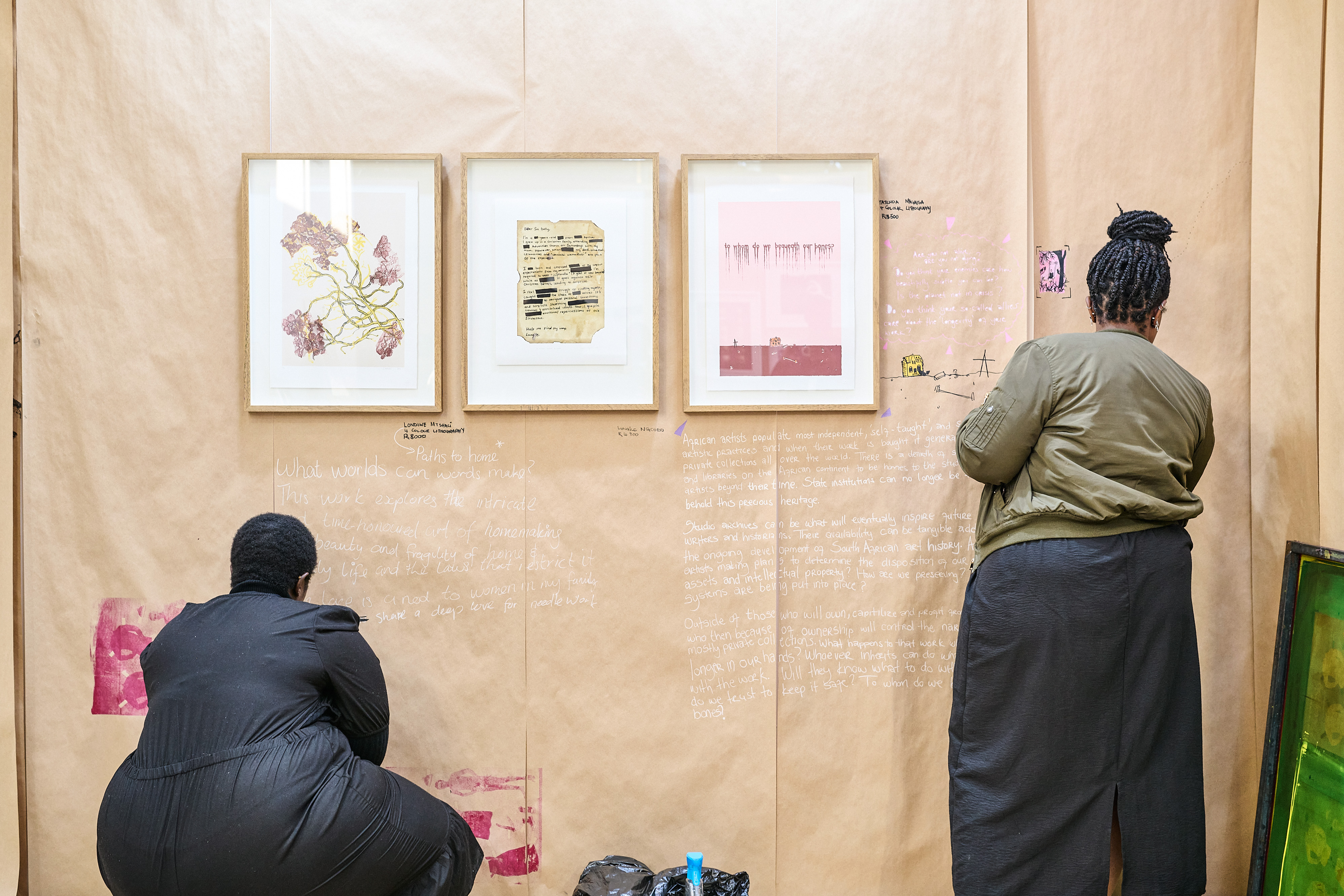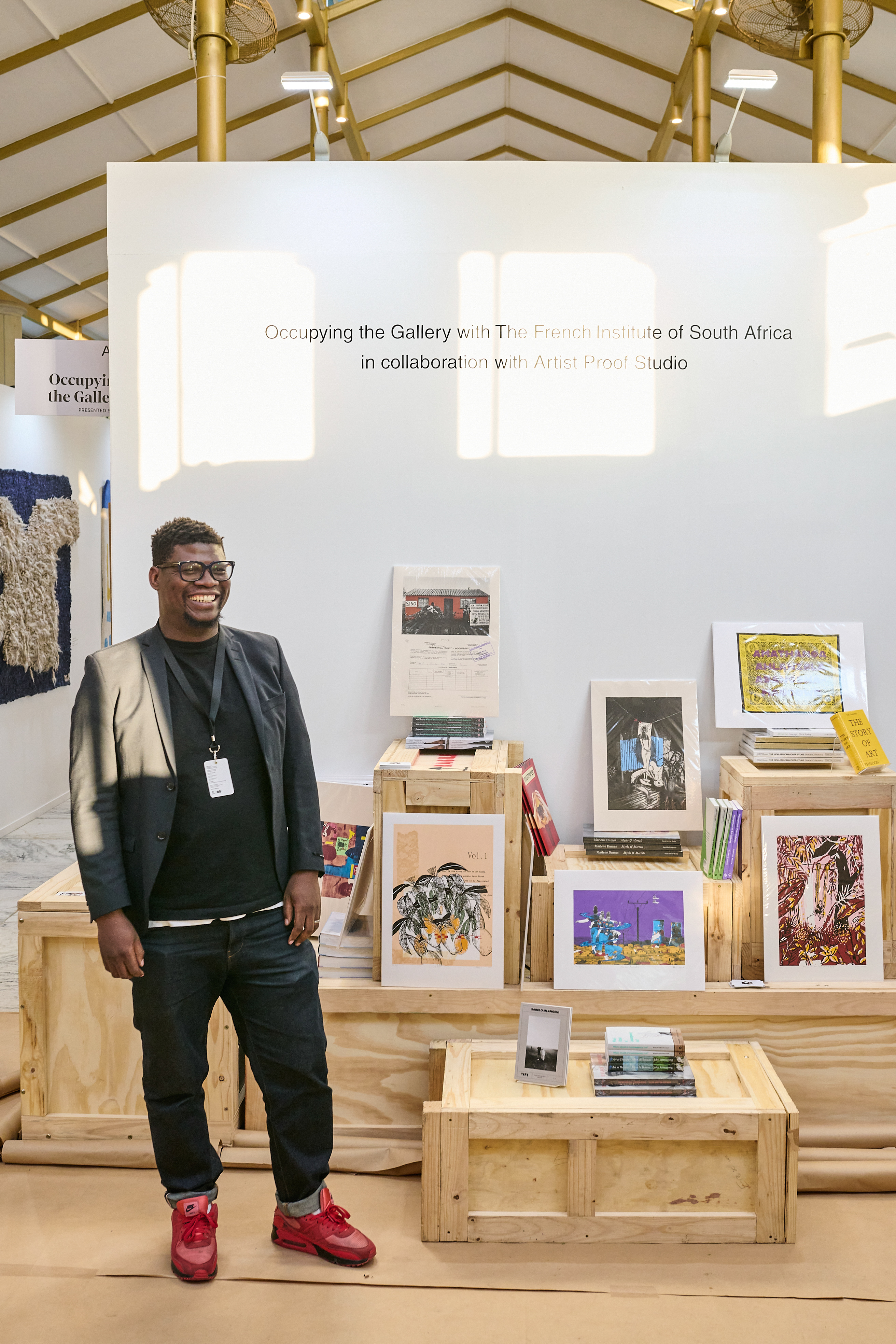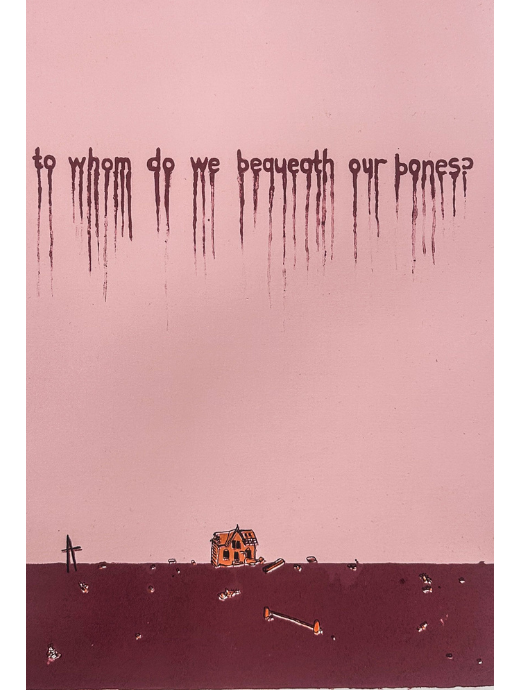Pathmaking and placemaking at the RMB Latitudes Art Fair
- By Xanthe Scout Lardner-Burke

-------------
A garden is a clever choice for a fair branding itself as emergent and fresh-faced. Clever, in the sense that gardens are emergent and disclosing. As a living space, they ask for a conspiratory cohabitation, an acknowledgment that space-making is a collaborative exercise.
Today the Gardens are tranquil, as I sit writing, a tiered water feature streams into a pool. Children crowd the base of the pool. ‘It must be magical to be a child here’ I think. Indeed, it is not sterile in the language we have come to associate with art fairs. Not sterile in white walls, or booths that line up consecutively. Aperol Spritz stands pepper the fair, and people lounge on manicured lawns. Even in its busyness, it is lazy, easy, languid. As I watch, a woman gestures to a chapel-like structure of specially imported sandstone, used to make an imitative structure less imitative. She is saying, “Yes that is our Bridal suite” to an old lady, who is saying “Oh how wonderful”.
At Latitudes I am acutely aware of the straddling of space – and time. It takes me a while to get my bearings. The tiered landscape and the odd buildings are ahistorical amalgamations without reference to time or place. As such, the landscape and structures seem to maze in on each other. Buildings share a syntax of appropriated approximations that make entrance and exit disorientating. This is exasperated by pathways that connect them haphazardly. The fair is situated across various structures – Mezzanine, Glass Marquee, Centre Court & Chapel to name a few. The programme describes the different spaces as hubs – “each of which showcases contemporary art galleries and exhibitions from across the continent”. More than centering activity, these spaces demand movement to and fro.
The tiered garden and double-volume buildings offer a variance to the way viewers see artwork. A marquee with a glass roof near the entrance makes for a clear view of the sky. Light trickles in and casts a shadow on Lucinda Mudge’s ‘Combat’ (2020). Shadow grants the work a depth, a place in a field of vision that allows one to measure proximity. I am thinking of how paintings shift and change colour under fluorescent, everyday indoor light. That light is sanitising, wiping a surface clean. Cleanliness suffers an artwork’s ability to take on space – cast shadow, bounce light, hold it. Remove the roof of the white cube, grub the senses, and suddenly the work can take on shape that demands reciprocity; an awareness of one's own body in relation to the work.
 Lucinda Mudge, Combat, 2020, CONTACT TO BUY
Lucinda Mudge, Combat, 2020, CONTACT TO BUY
The estate is available to the public for perusal during Open Gardens and privately, for venue hire. Art Fairs are so often considered events unto themselves. Appearing suddenly, as if by mirage, and disappearing as quickly as they appeared. There are no leading lines, beyond the apparition of the event, which seemingly produces itself. Shepstone Gardens lends the fair a shadow, some meatiness – or better, a worldliness – that gives the fair context. That produces something quite different. I am reminded of driving through Joburg for the first time, looking for jacarandas, shocked by the sheer monumentality of sprawling, high-walled suburbs. Steadily this wealth has been worn down, the shiniest pockets of the city frayed. Here, now, the estate feels nostalgic for that opulent whimsy – clandestine wealth. What does it mean to share in wealth like this? To access it, as we do here, fleetingly? Something is disquieting in the green space of the garden. It is true, that the garden may exist in a public memory repository beyond the fair. You may return to it, fixed as it is in sandstone and mortar and green. It is no mirage. And yet, I am aware that I am close to something private; intruding. Access itself is fleeting here, imbibed with time, and a proximity that one knows has been granted.
Art Fairs offer pathways of access to artists, exhibitors, and viewers – placemaking in an industry that so often hoards access. Latitudes serves to meet-you-half-way – to posit emergent work and spaces. Tim Ingold describes placemaking through path-making as “to be a place, every somewhere must lie on one or several paths of movement to and from places elsewhere”. Place-making is easier with people then, and lots of them. And it’s better on tiered ground.
I settle at Occupying the Gallery (OTG), which has a curved end-space at the ‘Rooftop’ section of the fair. I have climbed several winding flights of stairs to stumble upon it. At the ‘rooftop’ booths are open plan and run into each other, undivided except for a floating wall at OTG’s end-space. One can enter OTG on either side of the middle, floating wall, enabling a fluidity of movement and a muddling of entrance and access. Suspended from the tip-top of the booth walls, on the aforementioned sides, are rolls of brown paper. The paper curls at the point it meets the floor. Framed prints have been hung over the flank of this brown, sleek but scrappy surface. Annotations in many coloured pens and markers are written below and beside the prints. Various handwriting makes for a collaborative framework. The surfaces of the installation foreground a sense of construction - alteration, annotation, and temporality. It is an easy legend to the uncertainty and discrete nature of studio space and practice. On the internal side of the floating wall and opposite it, in a sort of vestibule enclave framed by a hodgepodge of ionic orders, are buttery wooden crates with an array of contemporary art books and individually wrapped prints. The display of these books and packaged prints is neat, and shopfront-like. In this way, the occupation functions as a middle space, a meeting space, between a shopfront and a studio. Much like a fair.

Exit through the Gift Shop is the third edition of Occupying the Gallery’s ongoing project, and riffs off Banksy’s popular documentary of the same name. The documentary/mockumentary points to a hierarchy of access and value, in reference to the weird practice whereby one exits a museum through a gift shop. Tracking value and access as they are abstracted in the museum, and gain tactility as they exit – disseminated from art objects to art paraphernalia. At this edition of the initiative book works and artworks are posited similarly, tilted only by the singularity of a frame hung at eye height in the centre of a wall. There is a flatness to this, a two-dimensionality, that the brown paper, with its handwritten notes, wears in. This paper accounts for some foreshortening – extending space and time. Books do something similar. They offer long-form engagement, more than any passer-by could digest in a single sitting, in a three-day fair. OTG is generous then, offering multiple points of access. And time for engagement beyond a single duration.
This project, founded by Mary Sibande and Lawrence Lemaoana is, as Lemaoana explains, “steeped in mentorship”. Founders attempt to construct pathways for young artists. The materials used are both abstract and tactile and situated in community, and collaboration, in what can be lent, borrowed, or inferred. Lemaoana and Sibande fund materials. Sibande lets artists use her studio. Much of the third edition’s group works there together and support is offered through this community. Magaisa, a writer and artist in the third edition says, “Essentially we are always together except on weekends or for doing other projects other than Occupying the Gallery”. Curatorially, the proximity of long-form bookworks close to artworks lends canon to emerging artists. They rub off on them. Similarly, Sibande and Lemoana’s status as well-known practitioners softens the barriers to entry, and in turn, the social hierarchy of fairs. The artworks at the fair, though distinct, share a timbre. The use of print media, lack of varied sizing, and the brown paper backing unify the artist’s work. Therefore, work is less distinguishable. Artists' voices are collectivised, as a distinctive authorial voice is abstracted.
Founders model collaboration. In each edition Occupying the Gallery works with a print studio. For Latitudes, it is Artist Proof Studios. Working in print is a means to offer fiscal support for artists to sustain their lives and practices. Treating the work – the focus of the work – as long-form, ongoing, and in-motion. Kim Gurney describes the “agential capacity for contemporary art to not only represent but also instantiate new realities” or “in short: for doing things with art”. Collaboration is a means to establish pathways that the artists may return to of their own accord – the fair, the print studio. Mentorship models place-making while busying itself with path-making. Indeed, Occupying the Gallery is not only simply constructing trajectories, but establishing a place-making that is tactile, long-term, and closely tied to their artists' lives.

Tatenda Magaisa, to whom do we bequeath our bones? (detail), 2023, R13,500.00 ex. VAT, CONTACT TO BUY
Returning to the gardens, I begin again scanning for a promising walkway. The estate is not ‘bigger’ from the various developments it has undergone. It simply has more paths and requires more movement. In this sense, the fair within the garden, the emergent space it affords RMB Latitudes is interactive and collaborative, in establishing pathways for placemaking in a multifaceted space.
This article was produced as part of the ARAK x Latitudes Critical Art Writing Workshop led by Ashraf Jamal over the course of the 2024 RMB Latitudes Art Fair.
Writer’s biography:
Xanthe Scout Lardner-Burke (b. 1998, South Africa) is an artist primarily, newly a curator, and most recently a writer. Her practice is process-based and expressive of [her] interest in materials, structures, language and value production. Scout Lardner-Burke graduated from Michaelis School of Fine Art (2021). She has exhibited with 99 Loop Gallery (Cape Town) in Artsy's Foundations, Untitled 9.99, Elemental, and With Feeling; the Association for Visual Arts in Together; Marvol Gallery in Beyond the Canvas and various independent curatorial projects since her graduation in 2021. In 2023, she participated in Sessions, an eight-month program, culminating in the exhibition Pomegranate (2023). In 2024 she curated her debut curatorial project Offcuts at the Association for Visual Arts. Most recently she has exhibited with 99 Loop Gallery at the Investec Cape Town Art Fair, and presented her solo show with the gallery, titled EXIT STRATEGY in April 2024. Scout Lardner-Burke works and lives in Cape Town, South Africa.
Further Reading In Articles
African Artist Directory















